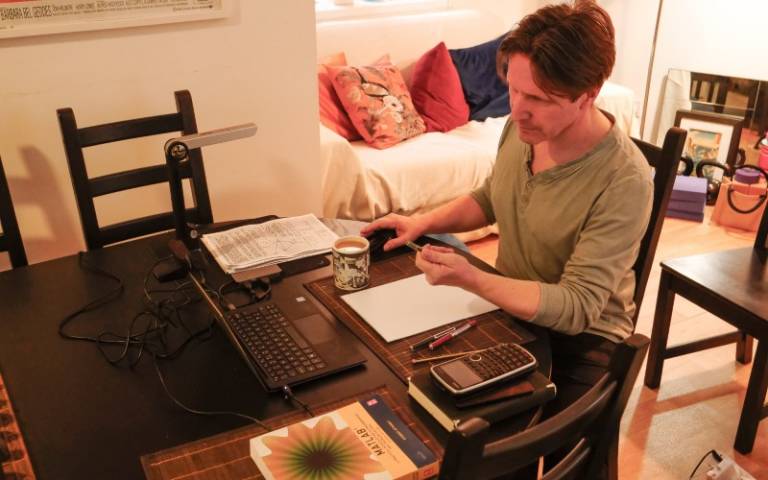Using Blackboard Collaborate to teach students across the world
Professor Marek Ziebart (Civil, Environmental and Geomatic Engineering) on online teaching and fighting back against the impact of COVID-19.

26 March 2020
On the day UCL made the decision to close down face-to-face teaching during the escalating coronavirus outbreak, Professor Marek Ziebart, trialled Blackboard Collaborate, a web conferencing platform, or virtual classroom, within Moodle.
Six days later, from his London flat, he hosted five hours of online teaching to twenty-one students.
Here, he shares his first-week experience of remote teaching and includes tips for staff and student success.
Jumping straight in
Blackboard can be used to run tutorials, group work, meetings and other virtual events. Despite being spread around the world everyone logged in to attend my online lecture. I could see everyone through their webcams, and they could interact with me, ask questions and use the online chat during the lecture.
I used multiple cameras to get the content over, including a document camera emulating a blackboard.
I was able to record the lectures and the recordings were easily accessible through Moodle after the event for any of the students to catch up and review the material.
Determination to keep students feeling part of UCL
Why did I take this approach?
I am determined to keep our students feeling part of UCL, and committed to carrying with their degree, whatever the circumstances.
I was actually thinking of the British Dunkirk spirit. We are in the midst of extraordinary times, but we can fight back against the chaos by being innovative and flexible.
Britain had the Royal Navy and a population with sailboats of all sizes, and they came together to deliver a miraculous outcome.
Whilst I am sure this is not a first at UCL, it is a very positive development.
Finding new ways to teach and interact
Perhaps what was novel is this: the format provides a new way to teach, it gives us ways to interact and to deliver content in a refreshing, novel environment.
Strangely, being able to see everyone’s faces via the webcams was at least as good as being in a classroom, and in some ways actually better. I could read everyone’s reactions as the material progressed.
Having the chat facility (it is a bar at the side of the screen on the interface enabling people to comment as we went along) adds another dimension to the lecture.
Setting it up
Moodle’s development at UCL seems to have gathered pace over the last two years.
I got the whole lecture series up and running in one afternoon, without any technical support.
It took about half an hour to figure out the interface. A few of us in the department had a virtual meeting online through Microsoft Teams and shared a few tips.
Emerging stronger and more flexible
UCL seems very well prepared to meet COVID-19 head-on and support its students in losing little momentum in their intellectual development.
We may even emerge stronger and more flexible from all this.
I think the students really enjoyed the lecture.
Many of them were at home, sitting by windows overlooking their gardens. One young man was on a boat.
Everyone seemed relaxed and tuned in. It felt great to be fighting back against COVID-19 by simply carrying on.
Supportive colleagues
I have to thank Dr Fiona Strawbridge, and the whole team involved in UCL Digital Education for setting up the facility.
My section head, Dr Jan Boehm, showed great leadership by pointing all of us at the technology and its resources, and my Head of Department, Professor Jose Terero was instrumental in encouraging his staff to carry on delivering teaching to all of our students, despite the challenges.
Plans to develop further
I want to explore the capabilities of the technology to innovate further in this space.
I’m going to transform my teaching materials to make them part of the overall portfolio of information. The integration of the recorded lecture and the online notes works very nicely.
I also want to start exploring this technology for MSc project supervision.
Under the current circumstances, it felt hugely rewarding to be delivering the teaching in an enjoyable, positive way. It felt great to connect with my students and see their faces as the penny dropped and ideas took shape.
 Close
Close

